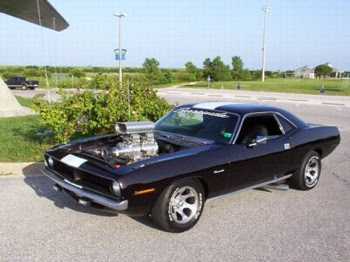 |
| Plymouth Barracuda 1964-1974 Book Cover-Amazon |
The First Muscle Car of original Plymouth Barracuda was built on the chassis body, which was also common to several other popular vehicles manufactured by Dodge Dart, including the Chrysler. It was directly spun off from existing Valiant series to appeal for a sportier market, and is also considered the pony car in the first place, because before the Ford Mustang came to market by two weeks.
 |
| Plymouth Barracuda Picture |
In 1967, the Barracuda car's body remained an A, but has been completely redesigned. To complement the fastback model, the vehicle now offered notchback and convertible options, replacing the 1966 versions. This second generation Barracuda would last three years, from 1967 to 1969. An interesting way to visually tell the difference in all three years were the side marker lights: the 1967 Barracuda HAD-side marker lights at all, the 1968 model had small circular ones and the 1969 model much larger rectangular HAD.
 |
| 1970 Plymouth Cuda Yellow-Open Engine |
In 1970, another reform was for the Barracuda. This new design looked a little different than previous models. One reason is that now was built on a new version, slightly shorter and more joyful Chrysler B-body platform in place, the E-body.
 |
| 1970 Plymouth Hemi Cuda Orange-Front Angle |
The New Baracuda eliminated the fastback, but kept the two-door coupe and convertible versions. He also had a twin brother known as the Dodge Challenger, not however, an exterior body panel exchanged between two cars. They were bulky, but aggressively and a clean style, although they were clearly influenced by the first generation of the Chevrolet Camaro. After moving to E-body platform, which featured a larger engine bay than the previous A-body Chrysler famous 426 in ³ (7.0L) Hemi would now be available from the factory in the Cuda. "
 |
| '69 Hemi Cuda fastback-Tom Hunsaker's |
No big changes for 1971 Barracuda: just a new grille and taillights. This would be the only year the Barracuda That would have four headlights, and also the only year of the optional fender "gills". In 1971 Barracuda engine options would remain the same as that of 70 years, except that now you could not ask for a 440-4bbl in his' Cuda.
1972 Plymouth Barracuda
In 1972, the Barracuda would keep the same general appearance of the ITS until 1974, with dual headlights and four circular lamps. But like other pony cars of the time, the great These Years showed a decrease in the Barracuda's power due to stricter emissions laws. The largest engine available in 1972 was the 340 4bbl, 360 was available in 1974. New rules also security force vehicle in front to have great guards and rear bumper in 1973 and 1974.
 |
| 1972 Plymouth Barracuda |
The Barracuda hanging until 1974, after he was stopped in the middle of the oil crisis of 1973. Production ended 10 years (one day) after it started. Although today they are sought after collector cars, the third generation was a market failure and never successfully competed with rival offerings from Ford and General Motors. The rarity of specific models and combinations today is primarily the result of low interest rates to the original purchaser and production.





















































